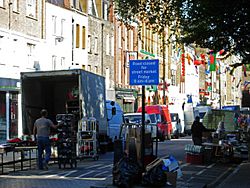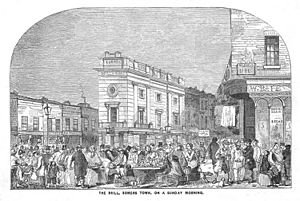Chalton Street Market facts for kids

Chalton Street Market in 2009
|
|
| Location | Somers Town, Camden, Greater London |
|---|---|
| Coordinates | 51°31′43″N 0°07′45″W / 51.528705°N 0.129149°W |
| Address | Chalton Street |
| Opening date | 1795 |
| Management | Camden London Borough Council |
| Owner | Camden London Borough Council |
| Environment | Outdoor |
| Goods sold | Fashion, Food, Household Goods |
| Days normally open | Friday |
| Website | camden.gov.uk/markets |
Chalton Street Market is a busy street market in Camden, North London. It's a great place to find all sorts of things, from fresh food to cool clothes.
Contents
History of the Market
How it Began (1795–1867)
Imagine a market that's been around for over 200 years! Chalton Street Market started way back in 1795. It was first known as 'The Brill'.
The area around the market, called Somers Town, began to grow with new houses in 1784. By 1795, the streets were all laid out. This is probably when the market first appeared.
Less than 60 years later, a writer named Henry Mayhew described it. He said The Brill market had about 300 stalls! This made it the second largest street market in London at the time.
The market got its name from 'The Brill House' tavern nearby. The area used to be known for some rougher activities. But the new homes and the market helped change that. It became a place where people could buy what they needed.
Mayhew wrote that the market sold lots of different things. You could find fresh fruit and vegetables, sweets, meat, and fish. They also sold crockery (dishes), clothing, and stationery.
These early street markets were very important. They helped London grow super fast in the late 1800s and early 1900s. Traders could easily move to new areas where people were settling. This meant people didn't have to travel far to buy food and goods. Many of these market spots later became London's main shopping streets.
Police in Charge (1867–1927)
At first, street markets were pretty wild and unregulated. But in 1867, a new law tried to stop street trading. People weren't happy about this! So, the law was changed quickly.
After the change, traders were allowed to continue. But now, the police started to manage the markets. They made sure things ran smoothly.
By 1887, the original Brill market site was gone. It was replaced by a railway depot. But the market traders simply moved to nearby streets. Somers Town stayed busy and noisy, especially on Saturday nights.
In 1893, Chalton Street Market had 97 stalls on a Friday. On Saturdays, it had 32 stalls. They sold food, clothes, and second-hand items.
Did you know about the Pearly Kings and Queens? Their founder, Henry Croft, was born in Somers Town in 1861. He was a road sweeper, not a market trader. But his colorful way of raising money for charity influenced market traders. You might have even seen Pearly Kings and Queens at the opening ceremony for the 2012 Summer Olympics!
Local Councils Take Over (1927–Present)
St Pancras Council (1927–1965)
In 1927, a new law changed how markets were managed. The police no longer ran them. Instead, local councils took over. They started giving out licenses to traders.
From 1927 to 1965, the Metropolitan Borough of St Pancras council managed Chalton Street Market. During this time, the market mainly sold fruit and vegetables. It was open only on weekdays.
Camden Council (1965–Present)
In 1965, the St Pancras council was replaced. Its area became part of the new London Borough of Camden. So, Camden Council has managed the market ever since.
By the early 1980s, the market was only open on Fridays. It sold clothing, jewelry, and second-hand books. It seemed to be struggling a bit. Most of the stalls were closer to Euston Road.
In the 1990s, the market was open Monday to Friday again. It had about 25 stalls on its busiest day, Friday. They sold household goods, canned food, and clothing.
Since 1998, a special event called the START (Somers Town Art) Festival of Cultures has been held. It happens on the second Saturday in July, right where the market is. It's the biggest street festival in Camden! About 10,000 people come to enjoy it. It brings together all the different cultures in the area.
The Market Today
Today, Chalton Street Market is open on Fridays. You can visit from 10:30 am to 3 pm. It's located along Chalton Street. You'll find a few stalls selling clothes, household items, and fresh food. Camden London Borough Council gives out the licenses for traders to set up their stalls.
Getting There
By Bus
Several bus routes stop near the market on Euston Road. These include routes 30, 73, 91, 205, and 390. Routes 168 and 253 serve Euston Station, which is also close by.
By Train or Tube
The market is easy to reach by train or tube. The closest stations are Euston railway, Euston tube, and Euston Square. You can also get there from King's Cross railway and King's Cross tube stations.


